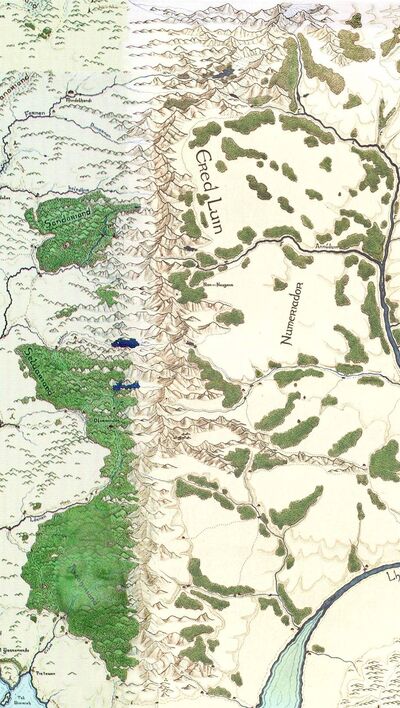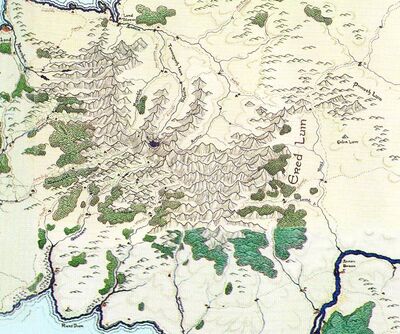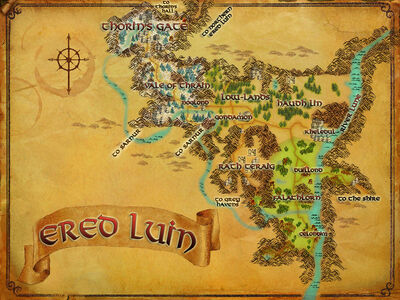

- Other Names: Ered Lindon, Ered Luin, Mountains of Lune, Western Mountains
- Length: 590 miles, from the Ice Bay of Forochel in the north to Orod Elwe (S. "Elwe’s Mountain") at the southern end of the range.
- Elevation: average peak elevation: 7.500-8,500; lowest peak Amon Othar (S. "Knight's Mound") 6.023 feet; highest peak Lossotil (S. "Snowy-peak") 9.497 feet.
- Climate: average annual precipitation: 30-40 inches; mean annual temperature 35 - 50°F; average low: Narwain -10°F; average high: Urui 80°F
- Composition: The Blue Mountains are predominately marble and limestone, with many natural caverns situated underneath. A high concentration of copper ores give the mountains a bluish tint when viewed from a distance. Once, the Ered Luin held precious metals, but millennia of Dwarvish occupation has reduced these stores to a trickle of gold in remote mines in the valleys. The Naugrim now base their industry on less exalted metals which are still present in abundance: copper, iron, and tin. The foothills are made up of folded sandstone and shale, providing a varied geological landscape.
- Notes: The peaks north of the Gulf of Lhûn are generally taller than those to the south. Some pine trees grow on the slopes, but they disappear over 5,000 feet. Snowfields and icecaps are present year-round on the northern range. The Dwarves built their cities of Nogrod and Belegost here in the First Age, and their descendants maintain their legacy with pride. When Beleriand was still intact to the west, the peaks were much higher than they are now. However, the cataclysm which caused Beleriand to sink beneath the waves also shattered many of the tallest mountains of the Ered Luin.
The majestic Blue Mountains (S. "Ered Luin") rose between Arthedain and Lindon. In the Elder Days, the Ered Luin had formed a continuous chain stretching from the Iron Mountains southward almost to the sea, separating Beleriand from Eriador. The Iron Mountains and Beleriand both foundered during the War of Wrath at the end of the First Age, and the Ered Luin were cloven in two by a great fissure in the earth. The chasm was filled by the sea to form the Gulf of Lhûn. The River Lhûn, whose tributaries drained much of the eastern slopes of the Blue Mountains, once flowed into Lake Nenuial, but now it emptied into the Gulf. The two halves of the mountain range were technically called the Forered Luin, on the north, and the Harered Luin, on the south — but few people used these names in conversation.
The Ered Luin were formed of a grey rock that displayed a bluish tint when seen from a distance. Their lower slopes were cloaked in pine forests, the dark needles contributing to the hazy blue silhouette. Most of the mountains in the range rose above the treeline, although only the highest peaks remained snow-capped year round, and mixed decidious and coniferous forests in the lowlands, consisting of oak, ash, and in the south, poplars and holly.
The highest peaks of the range were clustered north of the Dwarven Vale, their chief being Lossendil (S."Snowy-peak") which was at 9,497 feet the tallest. It was surrounded by the largest of several glacial ice fields found in the Blue Mountains; they got a great deal of rain on their western slopes, facing the sea, and snow-melt floods the rivers on all sides and kept the waters cold year round. The Forered Luin north of the Dwarven Vale were snow-capped year-round. More southerly peaks, including most of the Forered Luin and the highest mountains of the Harered bore snow in the winter months. The northern third of the Forered was exceptionally hazardous to climbers, rivalling the northern portion of the Hithaeglir, though more temperate portions were mainly dangerous for their steepness and the presence of large predators. North of these, the mountains bent north-east (twisted in the destruction of Angband), and declined in altitude. Formerly Dolmed and Rerir exceeded Lossendil in height (both later still stood about 6,000 feet). The southern-most peak was Orod Elu in Harlindon (6,824 feet).
The heirs of the flooded Dwarf-cities of Nogrod and Belegost made their homes in the the Blue Mountains. They dwelled in a collection of fourteen holds in the Nan-i-Naugrim (S."Dwarven Vale"), along the headwaters of the River Annuduin in the central Forered Luin. These were the Dwarves descended from the Firebeards and Broadbeams; they were ruled by the Kings of the Vale (about T.A. 1640 Thrar III). His hold was Merlost, built on the ruins of Belegost. Its smiths and artisans were among the best in the Vale.
Beyond the Blue Mountains lay the Outer World, the Etherim (Q. Ettele), the lands of woe. By the Fourth Age there were nearly as many Dwarves in these mountains as there were Elves in Lindon proper, though they never actually outnumbered the Firstborn. Like the Misty Mountains to the east, the Ered Luin were riddled with caves and crevasses. The mountains consisted mainly of marble and limestone, with granite in the northern range. Because of the high copper content of the peaks, many of the peaks seemed to gleam blue. Besides copper, tin, iron, and coal were all to be found in the veins of the range. Some veins of silver and gold were tapped and exploited by the Dwarves, but they were mostly gone by the late Third Age. However the ores gave them a respectable income and an important role in the economy of Eriador throughout the Third Age. Trade between the few Dwarves remaining in the mountains and the men of Arthedain was especially important, as the Naugrim were deft weapon-crafters as well as extraordinary jewelers and toymakers.

Both sections of the Ered Luin were also home to a few Giants, though they were seldom seen. This monstrous people had dwindled to a few dozen, but they were extremely long-lived. The Elves believed the Giants to be some sort of Mountain-Maia or Faerie, and their encounters were generally cordial, though the Giants were known to be unpredictable when dealing with Dwarves and Men. In most cases, the Elves were content to leave the hazards of the highlands to themselves as an aid to their defenses. Passes through the mountains were often concealed or secret, and warded by runes. The Blue Mountains were infamously disorienting to mortals.
Fewer Elves roamed the Mountains of Lune in the late Third and early Fourth Age, but the Dwarves in their holdings were still there and still working at their forges. The mines in Harlindon, which produced mainly coal, were occasionally opened by Dwarves desperate to earn a living. In the 30th century of the Third Age, Thorin Oakenshield was one of these forlorn refugees. Forging iron extracted from the region, he improved his fortunes and moved north to the Nan-i-Naugrim and better quarters. But it was said that a Dwarf needed gold to find more, and Thorin's prosperity resembled poverty when compared to the wealth of his forefathers. Brooding over the losses of his house, he grew hot for revenge on the dragon that had taken the Lonely Mountain from Durin's Folk. In T.A.2941, Thorin elected to seek the vengeance he desired and travel to Erebor, where Smaug awaited. His party came to Hobbiton that spring by way of the old trail north of the Cracking Fells. Lord Grar of Nibbin-grod, the mostly ruined Khazad holding above the Nan-i-Naugrim, sent his brother Gror to intercept Oakenshield. Riding southeast from Gamwich, Gror confronted Thorin on the day Gandalf chose Bilbo Baggins for his role as "burglar" on the quest to the mountain. After a night of violent argument in the woods outside Bywater, Thorin turned over to Gror all his possessions save those absolutely needed for the journey, as payment for debts of his house. Thus, Bilbo joined a party of Dwarves dispossessed of all but the most trivial weapons and armor. Several potent magical weapons went into Shire Mathom-houses in trade for ponies and food — some reappearing during Lotho Sackville-Baggins’ reign — and Thorin's harp spent the remainder of the Third Age in Grar's vaults.
Regions and Rivers[]
Annuduin Belechir Blue-crags Clovenvale Forered Luin Frostbluff Gebir Luin Grumpwood Harered Luin Helevorn Ilinlo Imlad Lalven Lalvenduin Lhûn Linduin Little Lune Nan-i-Naugrim Nen Hilith Nogothîr Vale Northern Passage Pinnath Luin Thorin's Gate Tum i-Theren Tumnogoth iaur
Settlements and Places of Interest[]
Amon Othar Amon Thanc Arming Caves Barad Caranthir Belegost Berghold Clovenvale Cluckland Crookdell Dol Ringwest Dolmed Edennogrod Edhelion Watch Ered Luin's Dungeons Ered Luin Homesteads Frerin's Court Frostmere Frostbluff Theatre Frozen Lake Geiloth Gondamon Grimwater Hunter's Notch Lamthir Lamath Limael's Vineyard Lossendil Lossotil Lowlands Mallost Merlost Mirkstone Tunnels Namfaldir Noglond Nogrod Nornhabar Northern Barricade Old Adanic Burial Site Orod Elwe Orodost Rath Teraig Refuge of Edhelion Refuge of the Feänorians Rerir Ringdale Rivergate Watch Rockbelly Pit Sarnúr Silver Deep Southern Barricade Telenaug Thorin's Gates Thorin's Hall Thorin's Hall Homesteads Thrási's Lodge Thrushstones Thunderhall Tum Agor Vale of Thrain Winterheight Winter-home
Inhabitants[]
About 1640: Blaggo Griffin Thrár III
About 3019: Grár Grór Gulla Múrin
References[]
- MERP: The Shire
- MERP Fan Modules: A Traveler's Guide to Lindon, by Jeff J. Erwin
- LOTRO: The Ered Luin
- LOTRO: Forochel
